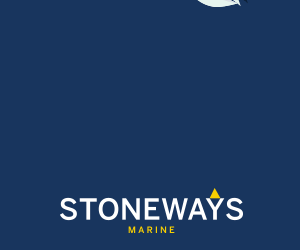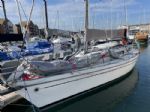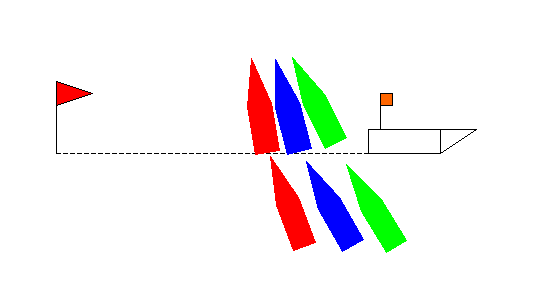











| Laser 140101 Tynemouth |
 |
| Rossiter Pintail Mortagne sur Gironde, near Bordeaux |
 |
| Laser 28 - Excellent example of this great design Hamble le rice |
 |
List classes of boat for sale |
Right of way with three or more boats |
Post Reply 
|
Page <12 |
| Author | ||||
NickA 
Really should get out more 
Joined: 30 Mar 05 Location: United Kingdom Online Status: Offline Posts: 784 |
 Post Options Post Options
 Quote Quote  Reply Reply
 Topic: Right of way with three or more boats Topic: Right of way with three or more boatsPosted: 14 Jul 10 at 8:48pm |
|||
|
As for my second example (not to scale - the boats came out too big!).
 Taking Brass's advice on treating the matter as two pairs of boats. A (red) has already tacked and B (blue) has tacked in response in order to keep clear - fine. For the next pair, B isn't hailing C (green) to tack and whether or not he should depends, I guess on how much B is really up against an obstruction. Problem is, it's a matter of judgement as to whether B can duck C or has room to tack back to starboard and duck A. How is C to know? (In the event, C called "starboard" and refused to tack; B complained that there was a boat beneath him avoiding the shore, but went head to wind to avoid a collision and stopped, then bore off below C whilst A sailed over the top of him - no-one took a penalty and C got ahead and won). That link probably answers the question .... but it doesn't seem to work for me. |
||||
|
Javelin 558
Contender 2574 |
||||
 |
||||
Brass 
Really should get out more 
Joined: 24 Mar 08 Location: Australia Online Status: Offline Posts: 1151 |
 Post Options Post Options
 Quote Quote  Reply Reply
 Posted: 15 Jul 10 at 2:49am Posted: 15 Jul 10 at 2:49am |
|||
|
Read rule 20 again. B's obligation is to tack (or hail 'You tack') in response to A's hail. If A tacks before B responds, then A probably breaks rule 20. Secondly, B's rule 20 obligation is to give A room to tack and avoid her, not to keep clear. But so be it: A and B have both tacked onto PORT and and are now approaching C on STBD.
Once on PORT, B has no entitlement whatsoever to hail C for room. Rule 20 only gives a boat an entitlement to hail a boat on the same tack. At the second position in your diagram, A and B are purely in Case 11 territory: two boats on Port approaching a boat on starboard. B may elect to duck C, in which case she must give A room to do likewise, or B may give A a rule 20 hail for room to tack away from C, and A must respond. If B uses rule 20 to tack away from C and A tacks, then, A will be entitled to give another rule 20 hail to B (because of the original obstruction), who must then respond, but by then, C will be out of the way and they can both get on with their race.
Well it's a matter of choice for B, but it is not a problem for C, who is the right of way boat, subject only to the rule 16.1 limitation that if she changes course she must give A and B room to keep clear of her.
See above. C certainly had no obligation to tack. It was up to A and B to keep clear of C. Going head to wind and slowing is a perfectly seamanlike way for B to honour her keep clear obligation. What you describe is pretty much exactly how the rules require the situation to play out. As we have discussed, under Case 113, had C been closer in on B's hip, then it would have been different and C would have been obliged to respond, although she could have responded by hailing 'You tack', slowing down, and still been able to put B about again. I suggest you consider the philosophy of rule 20 this way. Rule 20 is a safety rule that requires a boat, in a tactically controlling position to windward of a close hauled boat approaching an obstruction that safety requires her to tack away from, to sacrifice (or at least diminish) her controlling position (lead) in a limited and controlled way, so that the leeward boat can safely avoid the obstructon. Rule 20 allows the windward boat to minimise her detriment, and will penalise the leeward hailing boat if she abuses the rule. |
||||
 |
||||
JimC 
Really should get out more 

Joined: 17 May 04 Location: United Kingdom Online Status: Offline Posts: 6662 |
 Post Options Post Options
 Quote Quote  Reply Reply
 Posted: 15 Jul 10 at 8:50am Posted: 15 Jul 10 at 8:50am |
|||
To my way of thinking in that picture C is toast: not keeping clear when there's room to go up. If B and C established an overlap from behind A's only obligation is to give them enough room not to hit the Commitee boat. If they have to luff nearly head to wind to do it well that's tough. B may well escape: it depends on how the overlap with C was established. If B gained an overlap when A and C had room then its different from vv I believe. But yes, if A wants to close the door completely they have to do it early anough that B and C can tack before they reach the committee boat. Edited by JimC |
||||
 |
||||
Post Reply 
|
Page <12 |
| Forum Jump | Forum Permissions  You cannot post new topics in this forum You cannot reply to topics in this forum You cannot delete your posts in this forum You cannot edit your posts in this forum You cannot create polls in this forum You cannot vote in polls in this forum |
Copyright ©2001-2010 Web Wiz
Change your personal settings, or read our privacy policy











 Printable Version
Printable Version Delicious
Delicious Digg
Digg Facebook
Facebook Furl
Furl Google
Google MySpace
MySpace Newsvine
Newsvine reddit
reddit StumbleUpon
StumbleUpon Twitter
Twitter Windows Live
Windows Live Yahoo Bookmarks
Yahoo Bookmarks Topic Options
Topic Options B
B